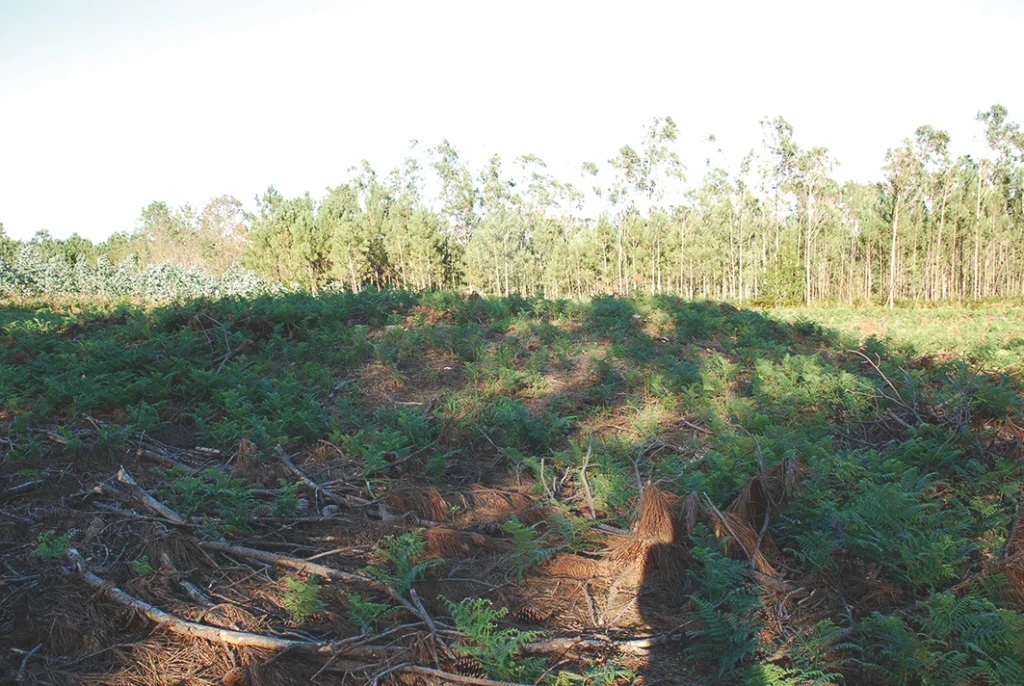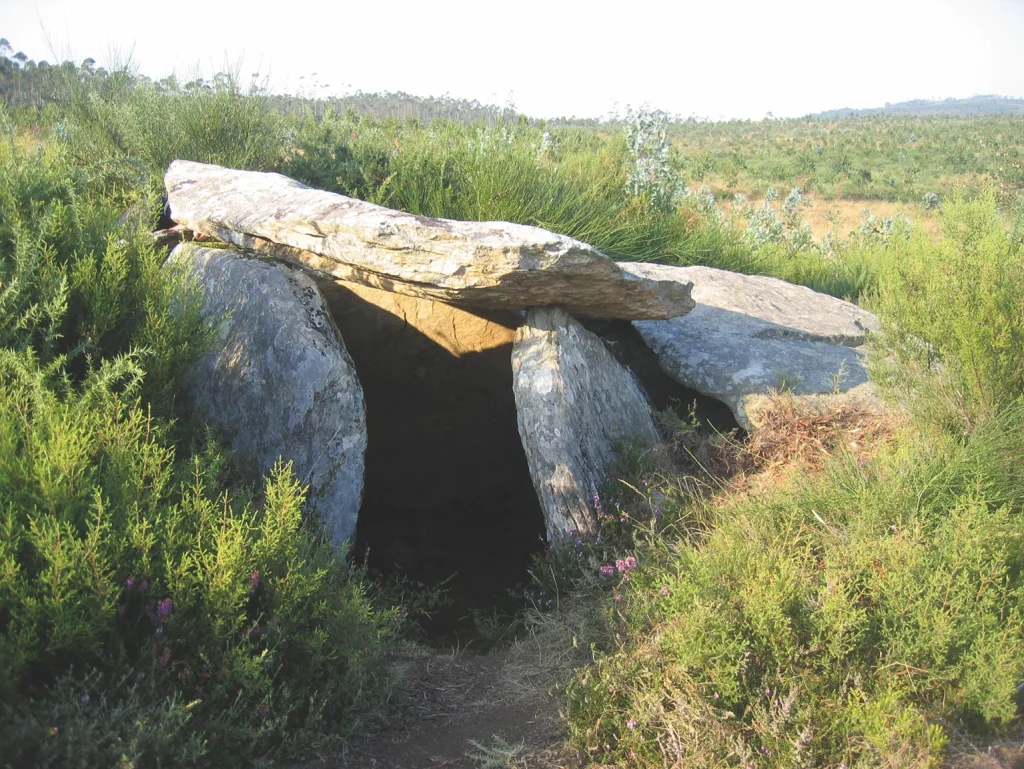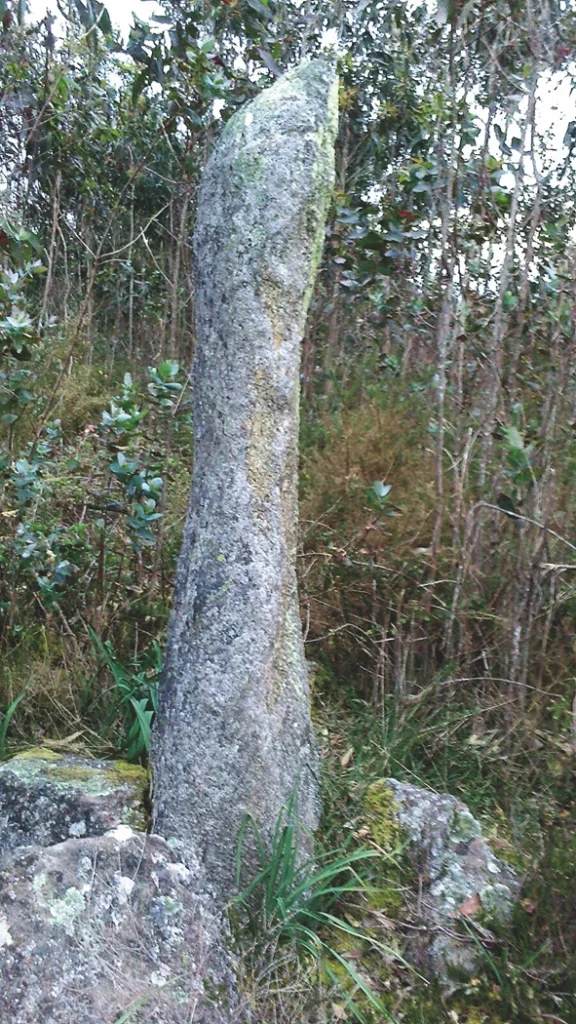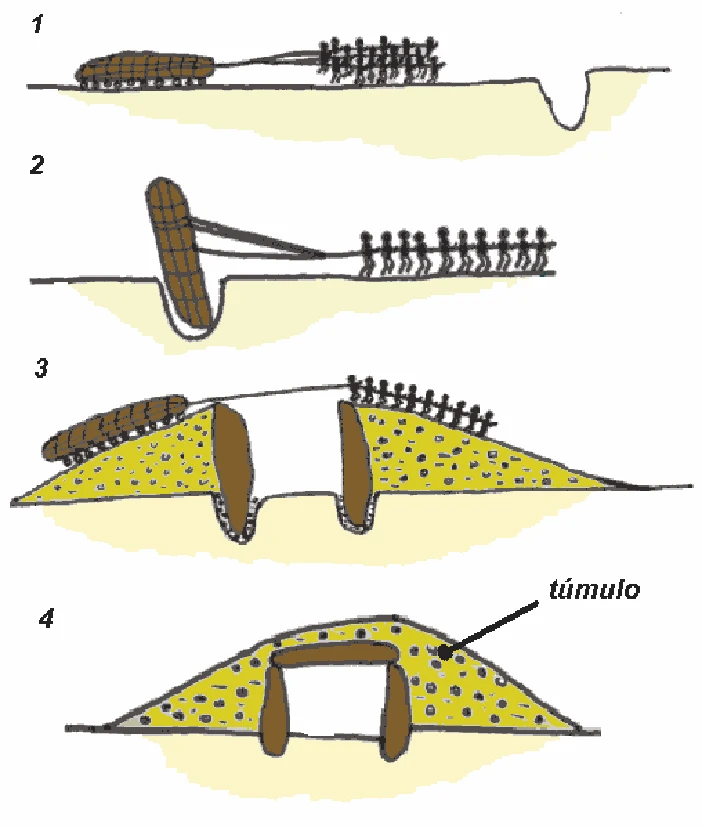Human occupation of Costa da Morte has a much longer history than the dates offered by the few stone tools discovered in places such as the lagoon of Alcaián (Coristanco) and Baldaio (Carballo). The humid and acid soil here, as in the rest of Galicia, does not allow bones to be conserved for very long periods.
The first culture for which we have abundant archaeological remains is the Megalithic. The oldest dating available for this culture is the beginning of 4,000 BCE, and the chronology in this case has been attributed by researchers to the first dolmens, such as ancient Dombate.
The term megalith comes from the Greek megas (large) and lithos (stone). Megalithic remains consist of a stone structure locally known as an anta or arca. Another term used is dolmen, a Breton word that means “large stone table”. The earth tumulus, sometimes reinforced with a stone coating, that surrounds this stone structure is locally known as a mámoa, medoña or medorra.
The most common shape of mámoas is circular or elliptical and their diameter varies between 10 and 30 metres. Their height above ground level varies between one and three metres. Many of the mámoas that hide an anta in their interior are gradually eroded by the passage of time and human activity and so reveal part of the structure of the burial chamber, i.e., the dolmens that we see today. However, in most cases what is seen is the earthen mound or tumulus, with a depression at the top caused by attempts to extract stones from the chamber for other uses or to find a treasure that was thought to be buried there. Such treasures clearly did not exist but were commonly believed to be there, especially in the early 17th century, when king Philip III granted a permit to Vázquez de Orxas to open the tumuli and take any treasure found within. This belief led to many mámoas being damaged. This sort of activity continues today, although it is now illegal. The construction of field tracks and other routes, as well as farming and forestry work, has led to the disappearance of part of this valuable historical heritage. Even so, more than 600 Megalithic sites, including mámoas and dolmens, have been catalogued in Costa da Morte.

Several stages or phases can be distinguished in the long history of the Megalithic culture, according to the type of monuments According to the archaeologist Antón Rodríguez Casal, there are three phases:
An initial period, from 3500 BCE to 3000 BCE, when the simplest enclosed polygonal or circular antas with just one chamber were built. An example would be the one at Dombate. An intermediate phase followed, which corresponds to a period of expansion of this type of funeral architecture, in which larger monuments were built with an entrance corridor facing east. This phase lasted approximately from 3000 BCE to 2500 BCE. The most important antas in Costa da Morte were built during this period: Dombate (Borneiro, Cabana de Bergantiños), Pedra da Arca (Cerqueda, Malpica) Pedra da Arca or Casa dos Mouros (Baíñas, Vimianzo), Pedra Cuberta (Treos, Vimianzo), Arca da Piosa (Muíño, Zas), Pedra Vixía (Lamas, Zas), Mina da Parxubeira (Eirón, Mazaricos), Pedra Moura (Aldemunde, Carballo) and Pedra Embarrada (Ferreira, Coristanco).
The final phase lasted from 2500 BCE to 2000 BCE, and is characterised by the construction of square or rectangular antas with one single covering. Examples of this type of anta would be the ones at Casota de Freán (Berdoias, Vimianzo) or Fornela dos Mouros (Nande, Laxe), which would be the last monuments of this type of collective burial. They were then replaced by smaller structures called cists, for individual burials, such as the one discovered in Taraio (Cerqueda, Malpica), now in the Archaeological and Historical Museum at the Castle of Santo Antón in A Coruña.

Alongside the dolmens and mámoas, there are other structures dating back to the megalithic period, such as pedras fitas or menhirs and stone circles or cromlechs. In the municipality of A Laracha, the menhir of Marco da Anta is still preserved and can be seen in the parish of Erboedo. It is some 2.05 metres high and the base measures about 74 cm in circumference. The archaeologist Luis Monteagudo publicised details of this menhir in 1950. There is another pedra fita or menhir on Monte Nariga, on the outskirts of the municipalities of Malpica and Ponteceso, called O Fuso da Moura, which measures 2.5 m in height and about 40 cm on each face in the middle.
As regards stone circles in this region, there are some references. The most famous one is A Eira das Meigas on Monte Neme, but the original has not been preserved. There is a replica near the location of the original circle.
The Megalithic culture appeared at a time when a series of changes were taking place in the social groups that lived in the region, which coincided with the Neolithic period, such as farming and livestock keeping, the invention of new tools made of polished stone and the use of ceramics. Innovations such as these were to lead to the first forms of sedentary life. These economic and social changes brought about a change in religious sentiments, which can be seen in a growing concern about life after death, which would explain the reasons behind the construction of all these funerary monuments throughout Costa da Morte and the rest of Galicia.

There is very little information about life in the communities that lived in this region more than 4,000 years ago and that left us their Megalithic architecture. There are no remains of their settlements, which were very probably built of perishable materials and because of their semi-nomadic lifestyle, which depended on pastoralism and itinerant farming.
The existence of many mámoas throughout the region, plus the ones that were destroyed and no longer exist, lead one to the conclusion that there was a fairly sizeable population dispersed around the territory, grouped into family clans that occupied specific areas, in which the tumuli acted as elements of group cohesion and domination of the space that they lived in.
The fact that these funerary monuments were used for collective burials indicates that the there was no clear stratification in the social structure. However, some kind of ruling class would have been necessary to direct hierarchically organised groups for structures of this size. This would also explain the differences between the remains that have been found. Transporting the massive slabs that formed the chamber from their place or origin and building the structures themselves would have required large groups of people.

These huge pieces of stone would have been transported by groups of people or animals using ropes to drag them or wooden rollers. Once the slabs had been transported, holes would have been dug to place the columns or upright slabs of the chamber and corridor, covering them with small stones; then earth would be placed on top to create the tumulus and inside to fill the chamber.
The tumulus would have been used as a ramp to drag the ceiling of the structure. Finally, the earth would be removed from inside the structure to make space in the chamber for the burials.
Few objects have been found inside or outside the antas. The lack of finds may be due to constant looting, the few excavations that have been carried out, and also to the poor state of conservation of many of the monuments. The objects that have been found include: small flaked stone tools such as knives and arrow heads, and others made of polished stone such as axes or adze heads. Adornments or cult objects, indicative of wealth or social distinction, such as necklace beads and idoliños (small idols). Pot remains are very common, ranging from simple open convex shapes to pieces with vertical walls, closed forms and straight lines. The pottery is grooved, incised, indented or beaker shaped.
Some slabs inside the dolmens have carvings. Their meaning is difficult to establish, as in the case of the figure called the The Ting in Dombate or the dolmen Pedra Embarrada, in Coristanco. Remnants of red, white and black paint have been found in others such as Pedra Cuberta, Casa dos Mouros and Dombate.
An outstanding example of the large antas or dolmens in Costa da Morte is Dombate, also known as the “cathedral of Galician antas”, excavated by the archaeologist Jose María Bello between 1987 in 1989. The finds included paintings on the slabs in the chamber and corridor distributed in horizontal lines, the discover of another previous monument within the mass of the tumulus, called “old Dombate” and the group of twenty idoliños found at the entrance to the corridor.
After the whole site was left under a plastic sheet or in the open air for over twenty years, it was finally covered in 2011 with a structure of wood and glass to protect the paintings. An interpretation and visitor reception centre was also built nearby. The monument receives about 30,000 visits a year.
Megalithic architecture is one of the major tourist assets of Costa da Morte, and so it should be cared for and appreciated. With this aim in mind, the regional government approved a project to create the Magalithic Park of Costa da Morte in 2003, but no further measures have been taken since then. In recent years the provincial council of A Coruña, which owns the dolmen of Dombate, has shown interest in instilling new life into the initiative with the collaboration of municipalities that have monuments of the period. An agreement between all the local administrations to move the project forward as soon as possible would do a great deal to preserve this example of the regional heritage.